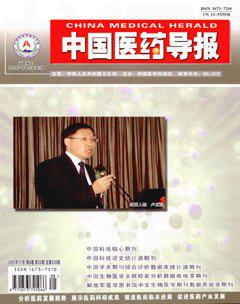双重染色内镜在消化道早癌诊断中的重要价值
殷桂香 王贞彪 乔进朋 鲁力峰 王晓燕
[摘要] 目的: 探讨双重染色内镜在消化道早癌中的诊断价值。方法:选取2009年1月~2010年12月间在丰台医院消化内镜中心进行胃肠镜检查的患者1 880例,分为观察组(406例)和对照组(1 474例),其中观察组进行内镜下醋酸-卢戈碘液、醋酸-美兰的双重染色,并行病理检查;对照组采取经验性活检取材病理检查,观察两组差异性。结果:观察组中,食管黏膜染色213例,总检出率为15.5%,早癌4例,中重度非典型增生及食管早癌检出率为8.0%;对照组588例,总检出率3.1%,中重度非典型增生及食管早癌检出率为1.2%,两组比较差异有高度统计学意义(P<0.01);观察组胃黏膜染色109例,总检出率66.1%,早癌7例,中重度非典型增生及早期胃癌检出率为24.8%,对照组548例,总检出率8.6%,中重度非典型增生及早期胃癌检出率为1.6%,两组比较差异有高度统计学意义(P<0.01);观察组肠黏膜染色84例,总检出率79.8%,早癌1例,中重度非典型增生及结直肠早癌检出率为10.7%,对照组338例,总检出率19.8%,中重度非典型增生及结直肠早癌检出率为0.6%,两组比较差异有高度统计学意义(P<0.01)。结论:内镜下醋酸-卢戈碘液、醋酸-美兰的双重染色法可提高消化道早癌及癌前病变的检出率,具有较高应用价值。
[关键词] 色素内镜;早癌;消化道
[中图分类号] R735 [文献标识码]B[文章编号]1673-7210(2011)11(c)-186-03
Important value of double staining endoscopy in diagnosis of early digestive tract cancer
YIN Guixiang1, WANG Zhenbiao2*, QIAO Jinpeng1, LU Lifeng1, WANG Xiaoyan1
1.Department of Gastroenterology, Beijing Fengtai Hospital, Beijng100071, China;2.Department of Gastroenterology, Beijing You'an Hospital Affiliated to Capital University, Beijing100069, China
[Abstract] Objective: To investigate the value of double staining endoscopy in the diagnosis of early digestive tract cancer. Methods: 1 880 patients who had received gastrointestinal endoscopy examination in the digestive endoscopy center of Fengtai hospital from January 2009 to December 2010 were selected and divided into the observation group (406 patients) and the control group (1 474 patients). The observation group received the endoscopic double staining of acetic acid-Lugol's iodine solution and acetic acid-methylene blue and parallel pathological examination, while the control group received empirical biopsy pathological examination. The differences between the two groups were observed. Results: In the observation group, there were 213 patients with esophageal mucosal staining and the total detection rate was 15.5%. There were 4 patients with early cancer and the detection rate of moderate and severe atypical hyperplasia and esophageal early cancer was 8.0%. In the control group, there were 588 patients with esophageal mucosal staining and the total detection rate was 3.1%. The detection rate of moderate and severe atypical hyperplasia and esophageal early cancer was 1.2%. There were significant differences between the observation group and the control group (P<0.01). In the observation group, there were 109 patients with gastric mucosal staining and the total detection rate was 66.1%. There were 7 patients with early cancer and the detection rate of moderate and severe atypical hyperplasia and early gastric cancer was 24.8%. In the control group, there were 548 patients with gastric mucosal staining and the total detection rate was 8.6%. The detection rate of moderate and severe atypical hyperplasia and early gastric cancer was 1.6%. There were significant differences between the observation group and the control group (P<0.01). In the observation group, there were 84 patients with intestinal mucosal staining and the total detection rate was 79.8%. There was 1 patient with early cancer and the detection rate of moderate and severe atypical hyperplasia and colon and rectal early cancer was 10.7%. In the control group, there were 338 patients with intestinal mucosal staining and the total detection rate was 19.8%. The detection rate of moderate and severe atypical hyperplasia and colon and rectal early cancer was 0.6%. There were significant differences between the observation group and the control group (P<0.01). Conclusion: The endoscopic double staining of acetic acid-Lugol's iodine solution and acetic acid-methylene blue can improve the detection rate of digestive tract early cancer and precancerosis, thereby of high application value.
[Key words] Pigment endoscopy; Early cancer; Digestive tract
染色法内镜(chromoendoscopy)又称色素内镜,应用于临床已有40余年历史。该项技术对早期消化道肿瘤的诊断价值明显优于普通内镜检查[1],国内多应用单一染色剂染色,作者在内镜检查过程中进行醋酸-卢戈碘液、醋酸-美兰的双重染色,与同期普通内镜检查比较分析,探讨双重染色内镜在消化道早癌中的诊断价值,现报道如下:
1 资料与方法
1.1 一般资料
2009年1月~2010年12月在丰台医院消化内镜中心进行胃肠镜检查的患者1 880例,分成观察组和对照组,观察组406例,男257例,女149例;年龄24~83岁,平均55.6岁;其中,胃镜322例,肠镜84例。对照组1 474例,男835例,女639例;年龄18~82岁,平均50.2岁;胃镜1136例,肠镜338例。除外进展期癌、溃疡、平滑肌瘤等,在常规检查发现可疑病灶(消化道黏膜有隆起、糜烂、粗糙不平、颜色改变)的同时,观察组进行内镜下双重染色,并行病理检查,对照组采取经验性活检取材病理检查,观察两组差异性。
1.2 方法
采用Olympus GIF/CF 240型电子胃/肠镜,检查发现病变后,于活检孔插入喷洒管接近病变,直视下先予生理盐水冲洗并吸引至黏膜表面清洁无黏液附着后喷洒2%醋酸溶液20 ml,1 min后以生理盐水冲洗,观察摄片,再予1.25%卢戈碘液(食道)或0.5%美兰(胃、结直肠)20 ml喷洒,1 min后以0.9%生理盐水冲洗,观察摄片,于病变显露部位取病理检查。
1.3 统计学处理
采用SPSS 13.0统计软件分析,计数资料采用χ2检验,P<0.05为差异有统计学意义。
2 结果
观察组406例染色病例中,食管黏膜染色213例,两组食管黏膜病变检出情况见表1。于浅染区取活检,病理报告食管炎22例,于不染区取活检,病理报告Barrett食管7例,早癌4例,总检出率15.5%,与对照组比较有显著差异(P<0.01)。观察组中重度非典型增生及食管早癌检出率为8.0%,对照组为1.2%,两组比较差异有高度统计学意义(P<0.01)。
胃黏膜染色109例,两组胃黏膜病变检出情况见表2。异常着色区域中,于着淡蓝色病变取活检病理报告萎缩/肠化生23例,轻度不典型增生22例;中度不典型增生15例,于着深蓝病变取活检病理报告重度不典型增生5例,早癌7例,总检出率66.1%。与对照组比较有显著差异(P<0.01)。观察组中重度非典型增生及早期胃癌检出率为24.8%,对照组为1.6%,两组比较差异有高度统计学意义(P<0.01)。
肠黏膜染色84例,两组肠黏膜病变检出情况见表3。于肿胀深染区域取活检病理报告腺瘤性息肉38例,轻度非典型增生20例,中度非典型增生3例,重度非典型增生5例,早癌1例,总检出率79.8%。与对照组比较有显著差异(P<0.01)。观察组中重度非典型增生及结直肠早癌检出率为10.7%,对照组为0.6%,两组比较差异有高度统计这意义(P<0.01)。
3 讨论
消化道早期癌症是指癌组织局限于黏膜下层以内,未累及固有肌层,包括黏膜内癌和黏膜下癌,而癌前病变主要指中重度不典型增生。消化道早癌由于病灶微小,普通内镜不易发现,容易漏诊和误诊,因此,如何早期发现至关重要。色素内镜的应用弥补了普通内镜的不足,染色后对小病灶的检出率可比常规方法提高2~3倍[2],达到早期诊断及治疗的目的。其原理是在一般内镜观察时辅助使用各种色素,从而使病变的形态及范围更清晰,继而有针对性地活检,以提高病变检出率。目前常用的染色剂有卢戈液、美兰、靛胭脂等。
卢戈碘液是诊断食管癌常用的色素之一。正常食管鳞状上皮内含有丰富的糖原,遇碘呈棕褐色,而柱状上皮则不染色。因食管癌细胞内糖原含量减少甚至消失,遇碘则呈淡染或不染色;不典型增生病灶的糖原含量减少,呈现不同程度的淡染。美兰正常黏膜不吸收,但可被糜烂、溃疡和癌组织吸收染成蓝色,可清楚地显示黏膜微细变化,常用于胃、结肠病变的诊断[3]。
单一色素法有其局限性, 由于染色剂浓度不一、喷洒方法不当、个体差异等因素, 可出现病变处染色深浅、定位不准确或病变遗漏等。作者通过临床观察发现应用新型染色剂醋酸进行食管、胃及结直肠的黏膜染色,可使病变明显显露,再配合卢戈碘液、美兰染色,病变形态及范围更趋清晰,从而提高诊断准确率。
醋酸喷洒胃黏膜后,细胞内pH下降,出现暂时性脱水,异常的核浆比例显现出来,细胞核妨碍光线传导,表现为上皮变白,2~3 min恢复原色。反应的强弱与细胞核内染色质的多少有关[4-5]。由于不正常上皮细胞核容量增加,因此,黏膜不典型增生区域得以显现。早期大肠癌的内镜下表现多样,隆起性的腺瘤癌变内镜下较易发现,而扁平型病变(Ⅱ型病变)内镜下则较易遗漏[6],俞力等[7]发现醋酸喷洒可增加全结肠隆起病变的检出率。
本组研究通过内镜下醋酸-卢戈碘液、醋酸-美兰的双重染色法,对可疑病变进行病理活检,结果食管中重度非典型增生及早癌检出率为8.0%,胃中重度非典型增生及早期癌检出率为24.8%,结直肠中重度非典型增生及早癌检出率为10.7%,明显高出对照组。提示醋酸-卢戈碘液、醋酸-美兰的双重染色法可提高消化道早癌及癌前病变的检出率,与文献[8]报道一致。
本组12例消化道早癌中9例内镜下表现黏膜红斑,微凹陷或凹凸不平的糜烂灶,经醋酸染色后病变边缘明显肿胀隆起,中央凹陷,再经卢戈液或美兰染色后,凹凸面对比显著。3例内镜下表现为微隆起病变,经醋酸染色后肿胀明显,边界清晰,再经美兰染色后,黏膜表面腺体结构趋显,可清晰地观察腺管开口形态。
内镜下醋酸-卢戈碘液、醋酸-美兰的双重染色方法简便,可提高消化道早癌及癌前病变的诊断率,具有较高应用价值,值得临床推广应用。
[参考文献]
[1]Kiesslich R, Von Bergh M, Hahn M, et al Chromoendoscopy with indigocarmine in proves the detection of adenomatous and nonadenomatous lesions in the colon [J]. Endoscopy,2001,33(12):1001-1006.
[2]张维国,王思霞,田晓丹.38例早期胃癌的胃镜诊断与临床分析[J].中华消化内镜杂志,2002,19(3):183.
[3]牛海静,王邦茂.色素内镜和电子色素内镜应用价值评价[J].中国消化内镜,2008,5(2):1-7.
[4]KaufmanH B, Harper DM. Magnification and chromoscopy with the acetic acid test [J]. Endoscopy,2004,6(8):748-750.
[5]于中麟,张澍田.消化内镜诊断金标准与操作手册[M].北京:人民军医出版社,2009:1.
[6]姜泊,刘思德,潘德寿,等.大肠侧向发育型肿瘤临床意义及诊治[J].现代消化及介入诊疗,2001,6(4):51.
[7]俞力,李鹏,于中麟,等.常规内镜窄带内镜全结肠色素内镜及全结肠醋酸喷洒对结肠病变发现率的对比研究[J].中国实用内科杂志,2008,28(3):202-204.
[8]Bruno MJ. Magnification endoscopy, high resolution endoscopy, and chromo-
scopy; towards a better optical diagnosis[J]. Gut,2003,52( Suppl4):7-11.
(收稿日期:2011-05-12)

